Drug Catalog - Product Detail
EZETIMIBE/SIMVASTATIN 10/40MG TB 90CT
| NDC | Mfr | Size | Str | Form |
|---|---|---|---|---|
| 45963-0567-08 | ACTAVIS | 90 | 10-40MG | TABLET |
PACKAGE FILES



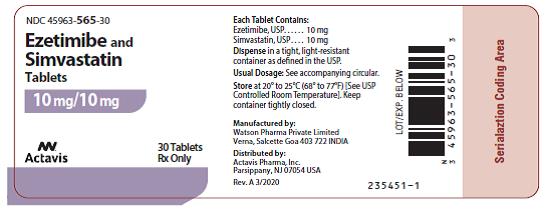

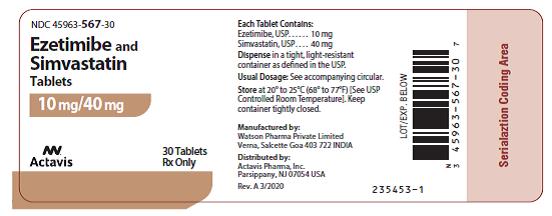
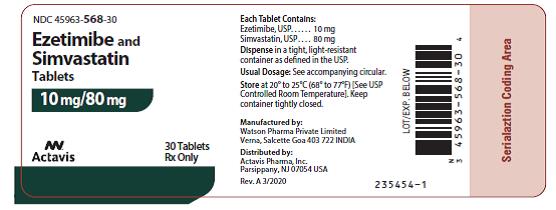




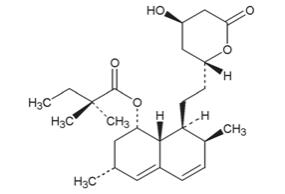
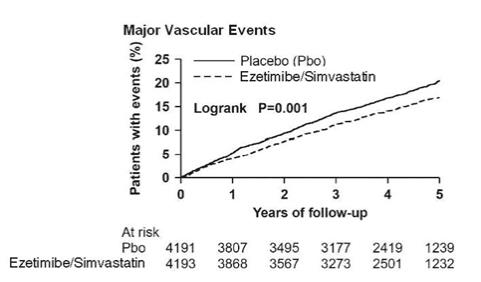


Generic Name
EZETIMIBE AND SIMVASTATIN
Substance Name
EZETIMIBE
Product Type
HUMAN PRESCRIPTION DRUG
Route
ORAL
Application Number
ANDA202968
Description
11 DESCRIPTION Ezetimibe and simvastatin tablets contain ezetimibe USP, a selective inhibitor of intestinal cholesterol and related phytosterol absorption, and simvastatin USP, an HMG-CoA reductase inhibitor. The chemical name of ezetimibe, USP is 1-(4-fluorophenyl)-3(R)-[3-(4-fluorophenyl)-3(S)-hydroxypropyl]-4(S)-(4-hydroxyphenyl)-2-azetidinone. The molecular formula is C 24 H 21 F 2 NO 3 and its molecular weight is 409.4. Ezetimibe, USP is a white, crystalline powder that is freely to very soluble in ethanol, methanol, and acetone and practically insoluble in water. Its structural formula is: Simvastatin, USP, an inactive lactone, is hydrolyzed to the corresponding β-hydroxyacid form, which is an inhibitor of HMG-CoA reductase. Simvastatin, USP is butanoic acid, 2,2-dimethyl-,1,2,3,7,8,8a-hexahydro-3,7-dimethyl-8-[2-(tetrahydro-4-hydroxy-6-oxo-2 H -pyran-2-yl)-ethyl]-1-naphthalenyl ester, [1 S -[1α,3α,7β,8β(2 S *,4 S *),-8aβ]]. The molecular formula of simvastatin, USP is C 25 H 38 O 5 and its molecular weight is 418.57. Simvastatin, USP is a white to off-white, nonhygroscopic, crystalline powder that is practically insoluble in water and freely soluble in chloroform, methanol and ethanol. Its structural formula is: Ezetimibe and simvastatin is available for oral use as tablets containing 10 mg of ezetimibe USP, and 10 mg of simvastatin, USP (ezetimibe and simvastatin tablets 10 mg/10 mg), 20 mg of simvastatin, USP (ezetimibe and simvastatin tablets 10 mg/20 mg), 40 mg of simvastatin, USP (ezetimibe and simvastatin tablets 10 mg/40 mg), or 80 mg of simvastatin, USP (ezetimibe and simvastatin tablets 10 mg/80 mg). Each tablet contains the following inactive ingredients: ascorbic acid, butylated hydroxyanisole, citric acid anhydrous, croscarmellose sodium, hypromellose, iron oxide black, iron oxide red, iron oxide yellow, lactose monohydrate, magnesium stearate, microcrystalline cellulose, and propyl gallate. formula 1 formula 2
How Supplied
16 HOW SUPPLIED/STORAGE AND HANDLING Ezetimibe and simvastatin tablets are supplied as follows: Strength How Supplied NDC Tablet Description 10 mg/10 mg unit of use bottles of 30 45963-565-30 Light tan, slightly speckled, round, unscored, biconvex tablet debossed with 511 on one side and on opposite side. unit of use bottles of 90 45963-565-08 10 mg/20 mg unit of use bottles of 30 45963-566-30 Light tan, slightly speckled, round, unscored, biconvex tablet debossed with 512 on one side and on opposite side. unit of use bottles of 90 45963-566-08 10 mg/40 mg unit of use bottles of 30 45963-567-30 Light tan, slightly speckled, round, unscored, biconvex tablet debossed with 513 on one side and on opposite side. unit of use bottles of 90 45963-567-08 10 mg/80 mg unit of use bottles of 30 45963-568-30 Light tan, slightly speckled, capsule shaped, unscored, biconvex tablet debossed with 515 on one side and on opposite side. unit of use bottles of 90 45963-568-08 Storage Store at 20° to 25°C (68° to 77°F). [See USP Controlled Room Temperature.] Keep container tightly closed. Dispense in a tight, light-resistant container as defined in the USP. 1 1 1 1
Indications & Usage
1 INDICATIONS AND USAGE Ezetimibe and simvastatin tablets Ezetimibe and simvastatin tablets are a combination of simvastatin and ezetimibe indicated: As an adjunct to diet to reduce elevated low density lipoprotein cholesterol (LDL-C): In adults with primary hyperlipidemia. In adults and pediatric patients aged 10 years and older with heterozygous familial hypercholesterolemia (HeFH). As an adjunct to other LDL-C-lowering therapies to reduce elevated LDL-C in adults with homozygous familial hypercholesterolemia (HoFH). Simvastatin Simvastatin, when used as a component of ezetimibe and simvastatin tablets, is indicated to reduce the risk of total mortality by reducing risk of coronary heart disease death, non-fatal myocardial infarction and stroke, and the need for coronary and non-coronary revascularization procedures in adults with established coronary heart disease, cerebrovascular disease, peripheral vascular disease, and/or diabetes, who are at high risk of coronary heart disease events. Ezetimibe and simvastatin tablets are a combination of ezetimibe, a dietary cholesterol absorption inhibitor, and simvastatin, an HMG-CoA reductase inhibitor (statin) indicated: ( 1 ) As an adjunct to diet to reduce elevated low density lipoprotein cholesterol (LDL-C): In adults with primary hyperlipidemia. In adults and pediatric patients aged 10 years and older with heterozygous familial hypercholesterolemia (HeFH). As an adjunct to other LDL-C lowering therapies to reduce LDL-C in adults with homozygous familial hypercholesterolemia (HoFH). Simvastatin Simvastatin, when used as a component of ezetimibe and simvastatin tablets, is indicated to reduce the risk of total mortality by reducing risk of coronary heart disease death, non-fatal myocardial infarction and stroke, and the need for coronary and non-coronary revascularization procedures in adults with established coronary heart disease, cerebrovascular disease, peripheral vascular disease, and/or diabetes, who are at high risk of coronary heart disease events.
Dosage and Administration
2 DOSAGE AND ADMINISTRATION Important Dosage and Administration Information: ( 2.1 ) Take ezetimibe and simvastatin tablets orally once daily in the evening with or without food. Maximum recommended dosage is ezetimibe and simvastatin tablets 10 mg/40 mg once daily. Ezetimibe and simvastatin tablets 10 mg/80 mg daily dosage is restricted to patients who have been taking ezetimibe and simvastatin tablets 10 mg/80 mg daily chronically (e.g., for 12 months or more) without evidence of muscle toxicity. For patients that require a high-intensity statin or are unable to achieve their LDL-C goal receiving ezetimibe and simvastatin tablets 10 mg/40 mg daily, prescribe alternative LDL-C-lowering treatment. If as dose is missed, take the missed dose as soon as possible. Do not double the next dose. Assess LDL-C when clinically appropriate, as early as 2 weeks after initiating ezetimibe and simvastatin tablets, and adjust the dosage if necessary. Adults : Recommended dosage range of 10 mg/10 mg to 10 mg/40 mg once daily. ( 2.2 ) See full prescribing information for ezetimibe and simvastatin tablets dosage modifications due to drug interactions. ( 2.3 ) Patients with Renal Impairment: Doses exceeding 10 mg/20 mg should be used with caution and close monitoring in patients with moderate to severe renal impairment. ( 2.4 ) 2.1 Important Dosage and Administration Information Take ezetimibe and simvastatin tablets orally once daily in the evening with or without food. The maximum recommended dosage is ezetimibe and simvastatin tablets 10 mg/40 mg once daily. The ezetimibe and simvastatin tablets 10 mg/80 mg daily dosage is restricted to adult patients who have been taking ezetimibe and simvastatin tablets 10 mg/80 mg daily chronically (e.g., for 12 months or more) without evidence of muscle toxicity [see Warnings and Precautions ( 5.1 )]. For patients that require a high-intensity statin or are unable to achieve their LDL-C goal receiving ezetimibe and simvastatin tablets 10 mg/40 mg daily, prescribe alternative LDL-C-lowering treatment. If a dose is missed, take the missed dose as soon as possible. Do not double the next dose. Assess LDL-C when clinically appropriate, as early as 4 weeks after initiating ezetimibe and simvastatin tablets, and adjust the dosage if necessary. 2.2 Recommended Dosage in Adult Patients The recommended dosage range of ezetimibe and simvastatin tablets 10 mg/10 mg to 10 mg/40 mg once a day. 2.3 Recommended Dosage in Pediatric Patients 10 Years of Age and Older with HeFH The recommended dosage range of ezetimibe and simvastatin tablets 10 mg/10 mg to 10 mg/40 mg once a day. 2.4 Recommended Dosage in Patients with Renal Impairment Renal impairment is a risk factor for statin-associated myopathy. Doses of ezetimibe and simvastatin tablets exceeding 10 mg/20 mg should be used with caution and close monitoring in patients with moderate to severe renal impairment [see Warnings and Precautions ( 5.1 ) and Use in Specific Populations ( 8.6 )]. There are no dosage adjustment recommendations for patients with mild renal impairment. 2.5 Dosage Modifications Due to Drug Interactions Concomitant use of ezetimibe and simvastatin tablets with the following drugs requires dosage modification of ezetimibe and simvastatin tablets [see Warnings and Precautions ( 5.1 ) and Drug Interactions ( 7.1 )]. Patients taking Lomitapide Reduce the dosage of ezetimibe and simvastatin tablets by 50%. Do not exceed ezetimibe and simvastatin tablets 10 mg/20 mg once daily (or 10 mg/40 mg once daily for patients who have previously taken ezetimibe and simvastatin tablets 10 mg/80 mg daily chronically while taking lomitapide) [see Dosage and Administration ( 2.1 )]. Patients taking Verapamil, Diltiazem, or Dronedarone Do not exceed ezetimibe and simvastatin tablets 10 mg/10 mg once daily. Patients taking Amiodarone, Amlodipine, or Ranolazine Do not exceed ezetimibe and simvastatin tablets 10 mg/20 mg once daily. Patients taking Bile Acid Sequestrants In patients taking a bile acid sequestrant, administer ezetimibe and simvastatin tablets at least 2 hours before or 4 hours after the bile acid sequestrant.
